A delicious homemade lasagne with rich beef ragu, creamy béchamel and golden cheese topping. A comfort food classic.
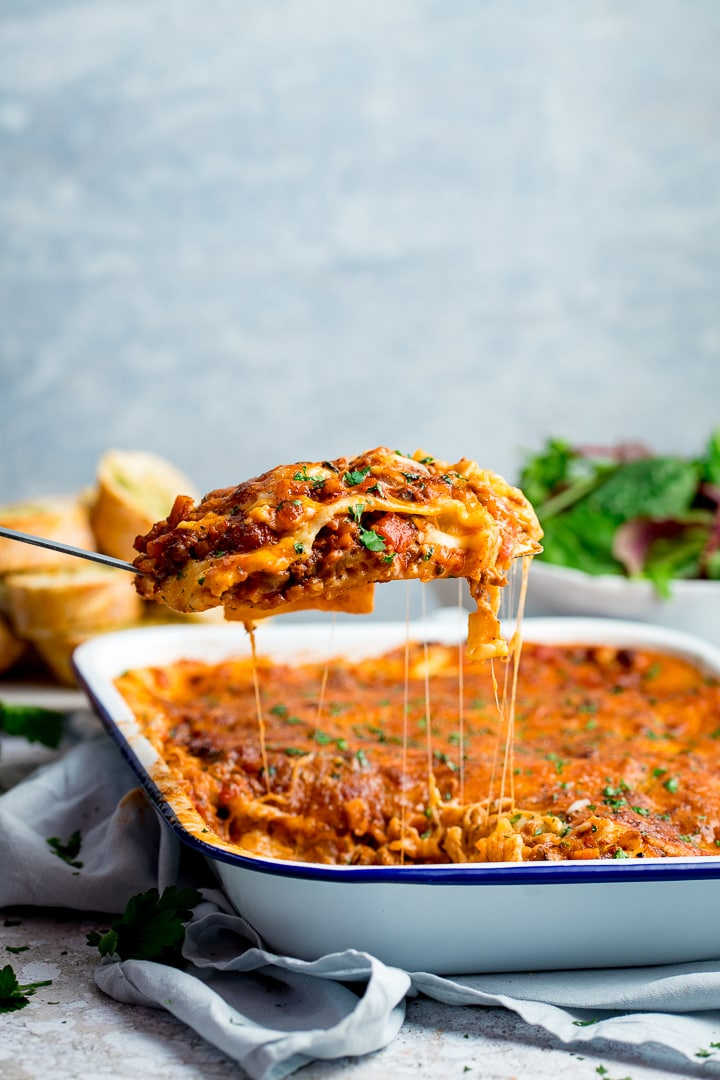
One hour from start-to-finish (and half of that’s in the oven) and you can be serving up a big meaty-cheesy dish of lasagne, with enough for second helpings. Because we all want second helpings when it comes to lasagne right?
Serve it with a big salad (I LOVE sliced red onions, crisp lettuce and some crunchy sliced radishes in my side salad) and some buttery garlic bread.
Ah. Dinner heaven.
🤔 Lasagna or Lasagne?
So what is the difference between Lasagne and Lasange?
Lasagna actually the singular form of lasagne. So you’d have one sheet of lasagna, but many would make up the dish lasagne.
Many countries, including the USA use lasagna as the spelling for the whole dish though (whereas the UK spell it lasagne).
🔪 How to make Lasagne
To make a classic lasagne we’ve got 3 key stages;
✔️ Make the Ragu
✔️ Make the Béchamel Sauce
✔️ Assemble and Bake
And I’m going to break down all 3 stages for you here, starting with the ragu.
1. The Beef Ragu
For a classic beef lasagne, we’re going to start by making the beef ragu.
This is very similar to my Spaghetti Bolognese recipe, so if you have some leftovers of that in the freezer (like I often do) then you could save yourself a bit of time.
We start by frying onion in a pan with a little oil. Add garlic, carrot and finely chopped mushrooms (this bulks out the dish and adds flavour).
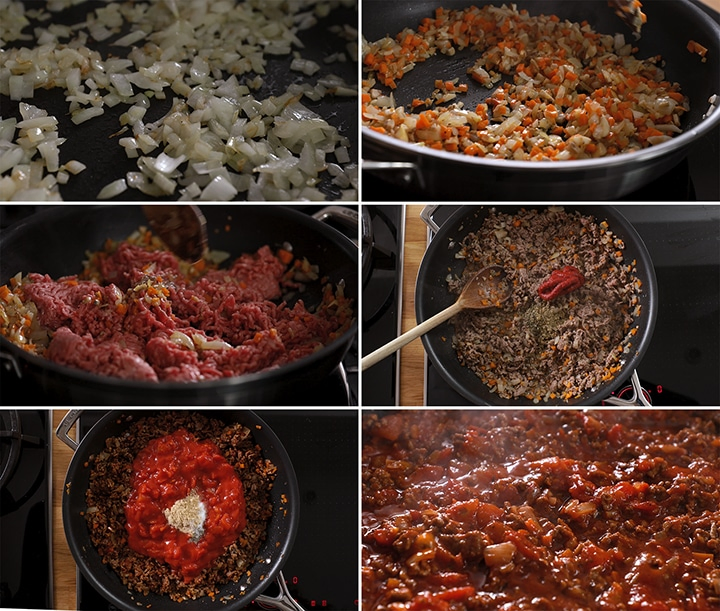
Once softened, add in the minced beef and brown in the pan, then add in tomato puree, oregano, thyme, Worcestershire sauce, a crumbled stock cube, tinned tomatoes, a little brown sugar and a good pinch of salt and pepper.
Stir, bring to the boil and simmer for 15 minutes while you make the béchamel sauce.
2. Béchamel Sauce (or white sauce)
The white sauce for lasagne is called béchamel sauce.
To make the béchamel sauce, melt butter in a saucepan, then stir in flour to form a paste.
Slowly stir in milk, and keep stirring (using a hand whisk) over the heat until thickened. Stir in cheese and a pinch of salt and pepper and turn off the heat.
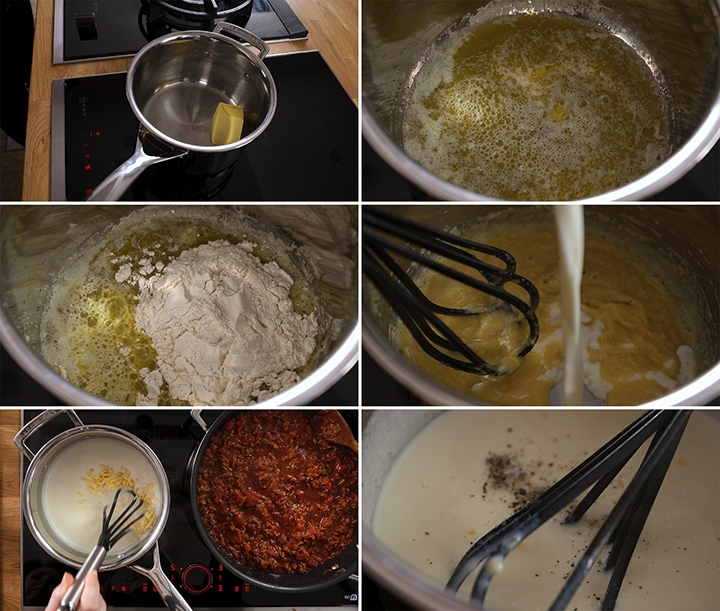
3. Assemble the Lasagne
Now take your lasagne dish (mine is a rectangular enamel roaster, approx 31cmx25cm and 5cm deep. Here’s the link enamel roaster (<–affiliate link)).
Spread a little of the meat sauce over the base of the dish. You don’t need a lot. It’s just to stop the lasagne sheets from sticking to the base of the dish.
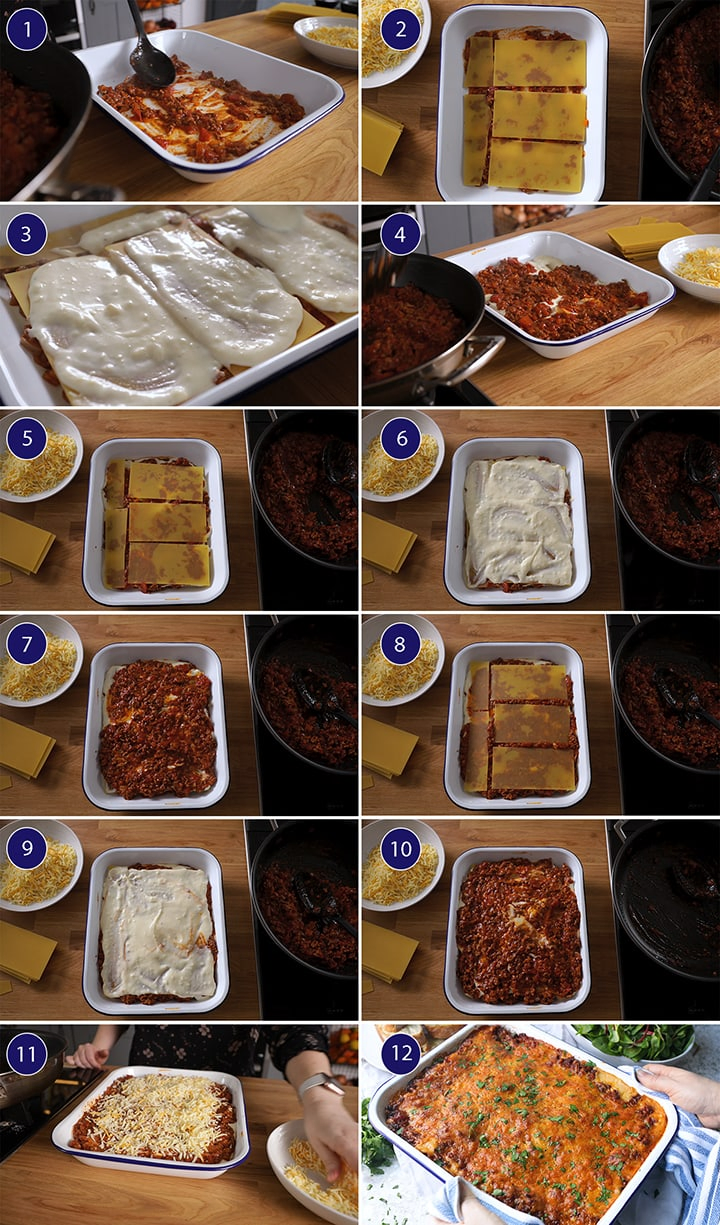
Top with lasagne sheets (try not to overlap, but we don’t want big spaces either). Then top with a third of the béchamel, followed by a third of the meat sauce.
Repeat twice more – lasagne ->béchamel->meat sauce->lasagne->béchamel->meat sauce.
Then sprinkle on the cheese and place in a preheated oven at 200C/400F for 25 – 30 minutes, until the cheese is golden.
👩🍳 PRO TIP – it will take at least 25 minutes until the pasta is cooked in the sauce – so if the top of your lasagne starts looking too brown, place some foil on top.
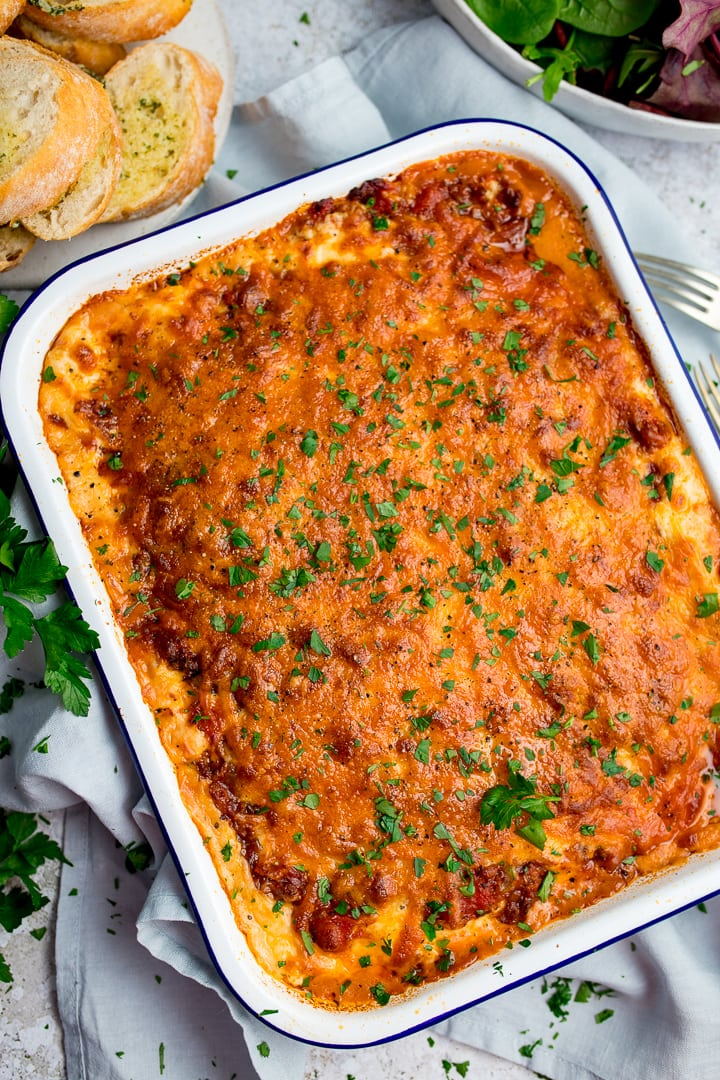
My usual non-blog lasagne is a quick two-layer thrown together thing, that comes out very saucy – i.e you have to spoon it out of the dish. A spatula isn’t going to do it.
This one uses three layers of pasta – which is the perfect sauce-to-pasta ratio to get it out neatly.
So, if you like extra saucy, kind of messy looking lasagne, go for two layers of pasta (same amount of meat and white sauce). If you like neater lasagne slices, go for three pasta layers. If you like it ridiculously saucy, just go for my lasagne soup (it’s a winner!).
👩🍳PRO TIP if you want your lasagne to look really neat – we’re talking razor-sharp edges here – make it ahead, let it cool completely, refrigerate it, then reheat it. During that time the pasta will soak up more liquid, leaving you with a sharp finish. I didn’t do this, because, well I couldn’t wait and I wanted to eat it.
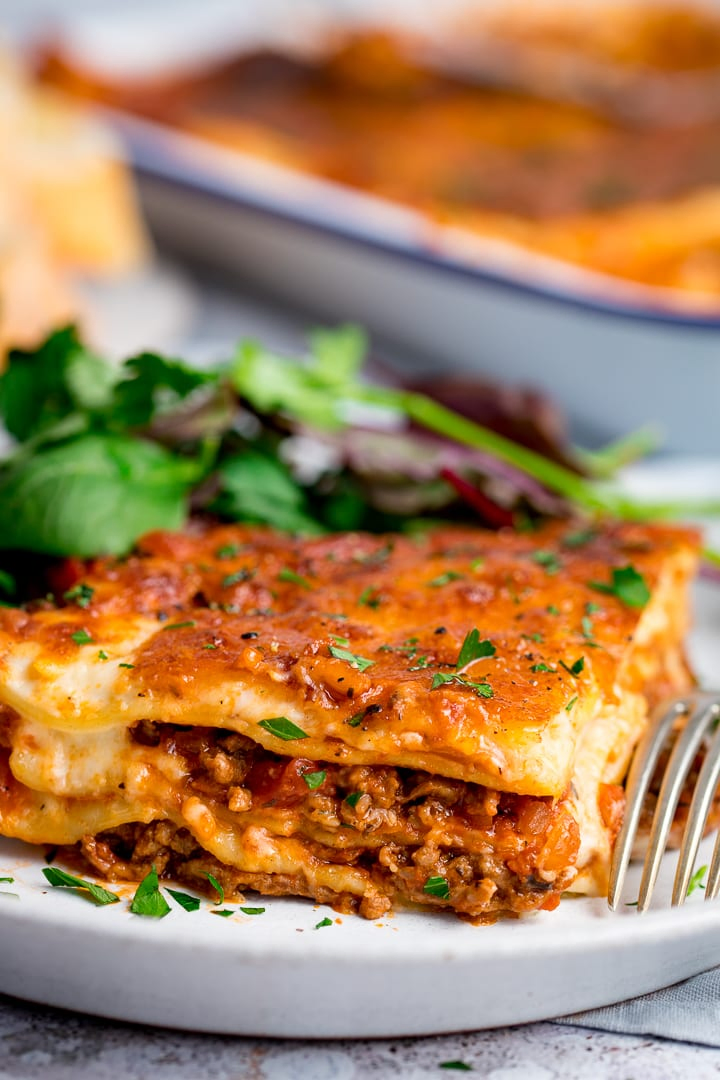
❓ FAQs
Yes, make the lasagne and bake it for 20 minutes – until the cheese is lightly browned. Then cool, cover and refrigerate for up to 2 days. Take out of the refrigerator an hour before you want to bake it – to allow it to come up to room temperature (this helps to avoid cold spots in the middle when you reheat). Place in the oven, covered in foil for 20-25 minutes at 200C/400F until piping hot throughout.
Yes, make the lasagne and bake it for 20 minutes – until the cheese is lightly browned. Then cool, cover and freeze. Defrost in the refrigerator overnight and then take out of the refrigerator an hour before you want to bake it – to allow it to come up to room temperature (this helps to avoid cold spots in the middle when you reheat). Place in the oven, covered in foil for 20-25 minutes at 200C/400F until piping hot throughout.
My lasagne is made using dried pasta – the kind that you don’t need to pre-cook. I find this is easier to store (I always have it on hand in my cupboard), it lasts longer and it absorbs more of the flavour of the sauce than fresh lasagne sheets.
If you wanted to buy or make fresh pasta then, fresh lasagne sheets are useful if you want your lasagne to cook quicker (although they can sometimes require pre-cooking in boiling water for a couple of minutes). I find it takes at least 20 minutes to get a lovely golden brown cheese topping anyway. So using fresh pasta sheets doesn’t really save me any time overall.
And as for dried lasagne sheets that need pre-cooking in boiling water? I avoid them at all costs. No-one needs to waste their time on that! Plus I find they can stick together unless you use water and lots of olive oil in your pan. Too much effort!
A Classic Lasange would usually have three or four layers of pasta.
I find that this is the ideal amount (and the most common), but you can have more if you have enough sauce to cover the layers!
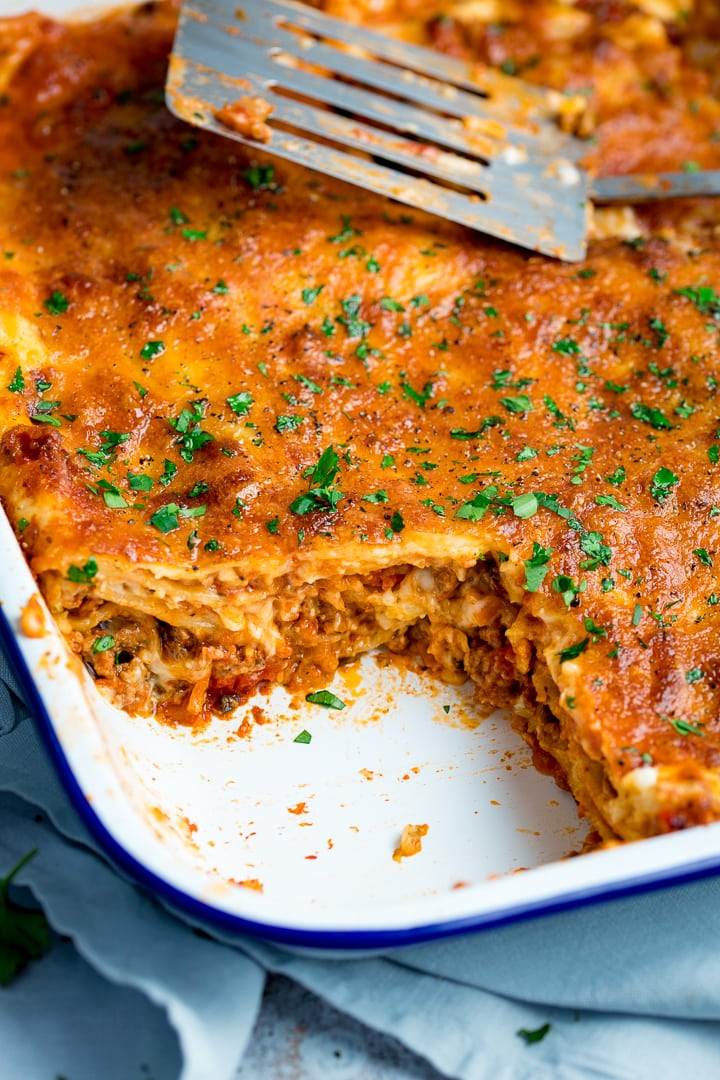
🍽️ Serving Suggestions
Salad is always a winner – I like a simple salad of thinly sliced red onions, crisp lettuce and some crunchy sliced radishes, but if you want something a little more fancy, how about this cobb salad?
No-one’s going to refuse garlic bread! or if you want an upgrade, try my homemade cheese and tomato garlic bread.
Fries! Again, shop-bought are good, but for something special how about homemade veggie matchstick fries or chilli and garlic oven fries? Or you could also serve it with some sauteed potatoes
📺 Watch How To Make It

🍝 More Italian inspired recipes
- 30 Minute Spaghetti Bolognese (my 14 year old has memorized how to make this go-to recipe)
- Tuscan Chicken
- Chicken Carbonara
- Slow Cooker Pork Ragu
- My Spaghetti and Meatballs Recipe
- Comforting Tuscan Chicken Soup
- Penne Arrabiata with Mozzarella and Chorizo
- Crispy Fried Ravioli With Spicy Tomato Dip
- White Bean Soup with Parmesan and Pesto
- Chewy Amaretti Cookies
Stay updated with new recipes!
Subscribe to the newsletter to hear when I post a new recipe. I’m also on YouTube (new videos every week) and Instagram (behind-the-scenes stories & beautiful food photos).
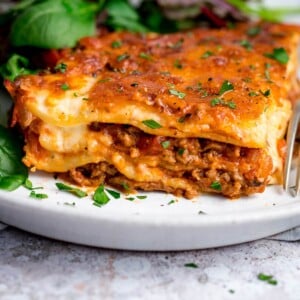
Lasagne Recipe
Ingredients
Meat Sauce:
- 1 tbsp olive oil
- 1 onion peeled and finely diced
- 2 cloves garlic peeled and minced
- 1 carrot peeled and finely diced
- 3 chestnut (brown) mushrooms finely diced
- 500 g (1.1 lbs) minced beef (ground beef) 12-20% fat, don’t go for the really lean stuff, it’s too dry
- 3 tbsp tomato puree paste for US
- 1 tsp dried oregano
- ½ tsp dried thyme
- 1 tbsp Worcestershire sauce
- 1 beef stock cube crumbled
- 2 x 400 g (2 14oz) tins chopped tomatoes
- ½ tbsp light brown sugar
- ½ tsp salt
- ½ tsp black pepper
Béchamel Sauce:
- 4 tbsp butter salted or unsalted is fine
- 4 tbsp plain (all-purpose) flour
- 720 ml (3 cups) full-fat milk
- pinch salt and pepper
- 100 g (1 packed cup) cheddar cheese grated
Also:
- 12 sheets of dried lasagne the kind you don’t need to pre-cook
- 175 g (1 3/4 cups) mixed grated cheese I use a combination of regular cheddar, red cheddar and mozzarella
- 1 tbsp finely chopped fresh parsley
Instructions
Ragu:
- Heat the oil in a frying pan over a medium-high heat. Add the onion and cook for 5 minutes, stirring often, until the onion softens.1 tbsp olive oil, 1 onion
- Add the garlic and cook for a further minute.2 cloves garlic
- Add the carrot and mushrooms and cook for a further 2-3 minutes.1 carrot, 3 chestnut (brown) mushrooms
- Add the minced beef and cook for 5-6 minutes, until browned. Stir often, breaking up any large chunks of meat with a spatula.500 g (1.1 lbs) minced beef (ground beef)
- Add the tomato puree, oregano, thyme, Worcestershire sauce, beef stock cube, tinned tomatoes, brown sugar, salt, and pepper. Stir and bring to the boil. Turn down the heat and simmer for 15 -20 minutes until thickened.3 tbsp tomato puree, 1 tsp dried oregano, ½ tsp dried thyme, 1 tbsp Worcestershire sauce, 1 beef stock cube, 2 x 400 g (2 14oz) tins chopped tomatoes, ½ tbsp light brown sugar, ½ tsp salt, ½ tsp black pepper
Béchamel Sauce:
- Meanwhile, preheat your oven to 200C/400F (fan) and start on the Béchamel Sauce:
- In a medium sized saucepan, add the butter and melt over a medium heat.4 tbsp butter
- Once melted and bubbling slightly, add in the flour and whisk it into the butter.4 tbsp plain (all-purpose) flour
- Keep gently whisking the roux over the heat for one or two minutes to cook the flour. Add in a good splash of milk, turn up the heat and stir with the whisk to incorporate.720 ml (3 cups) full-fat milk
- Keep adding in the milk a good splash at a time, and whisking until all the milk is used up (this normally takes me about 3 or 4 minutes and I add the milk in about 5 splashes). Don’t worry if you get a few lumps, keep stirring with the whisk and they will disappear as the sauce thickens.
- Keep stirring the sauce with the whisk over the heat until your sauce thickens. Once thickened, add in the salt, pepper, and cheddar. Stir together and then turn off the heat.pinch salt and pepper, 100 g (1 packed cup) cheddar cheese
Now it's time to construct your lasagne (SEE NOTE 1):
- Spoon a couple of tablespoons of the meat sauce into the lasagne dish and flatten it so it covers the base. You don't need much – this is just to ensure the lasagne sheets don't stick to the bottom of your dish. Then cover with 4 lasagne sheets. Try to ensure they don’t overlap. You may need to break up one of the sheets to cover the dish fully.12 sheets of dried lasagne
- Spoon on a third of the béchamel sauce and spread it around to cover the lasagne sheets,
- Then cover with a third of the remaining meat sauce.
- Place a layer of lasagne sheets on top. Followed by a layer of béchamel sauce and meat sauce. Repeat one more time, until all of the sauce and lasagne sheets are used.
- Sprinkle the mixed cheese on top.175 g (1 3/4 cups) mixed grated cheese
- Place in the oven and bake for 30 minutes until the cheese is golden and the lasagne is bubbling slightly at the edges.
- Take out of the oven and leave to rest for 5 minutes before sprinkling with parsley and serving.1 tbsp finely chopped fresh parsley
Video

Notes
Nutrition
Nutrition information is automatically calculated, so should only be used as an approximation.
This post was published in Nov 2019. Updated Oct 2020 with additional tips and for housekeeping reasons.
Some of the links in this post may be affiliate links – which means if you buy the product I get a small commission (at no extra cost to you). If you do buy, then thank you! That’s what helps us to keep Kitchen Sanctuary running. The nutritional information provided is approximate and can vary depending on several factors. For more information please see our Terms & Conditions.
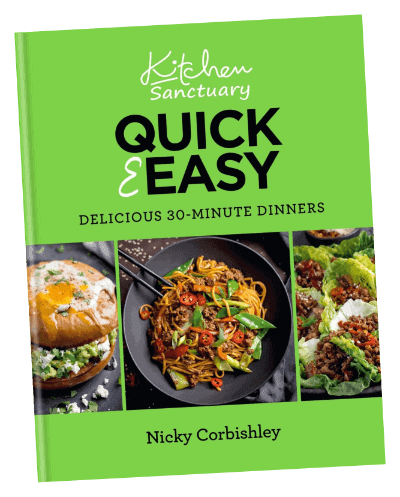




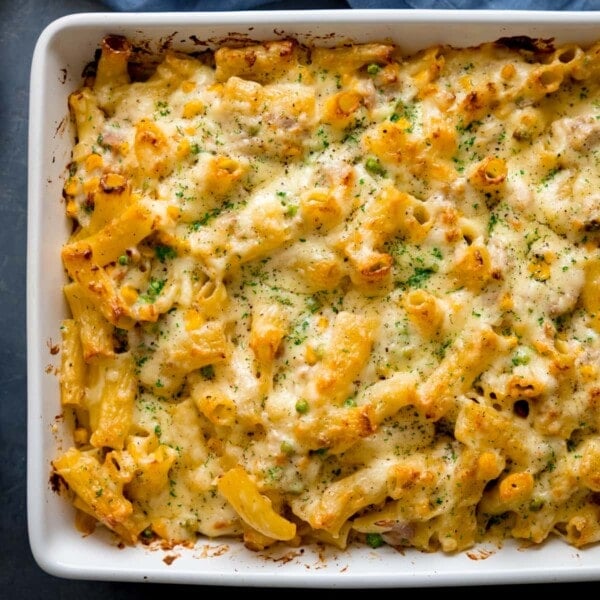
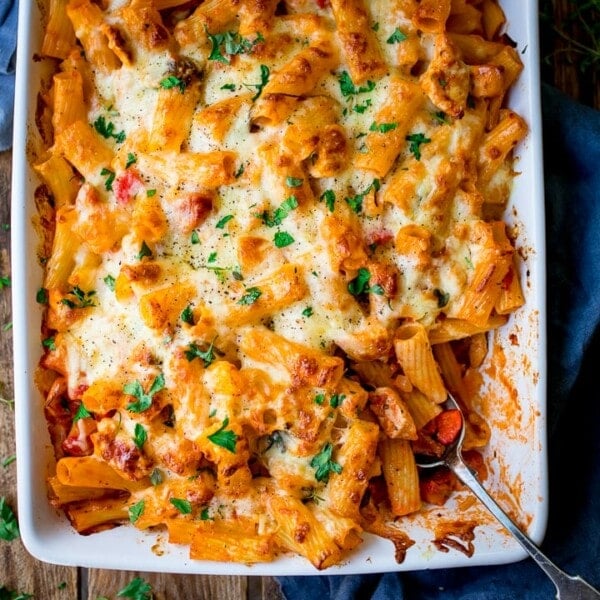
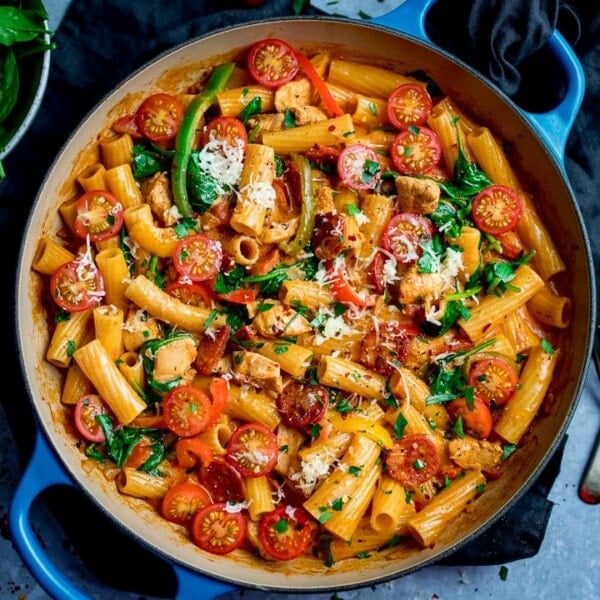
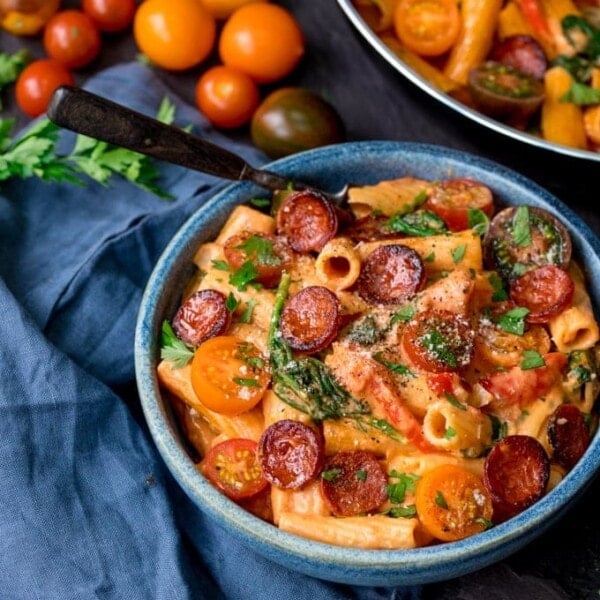
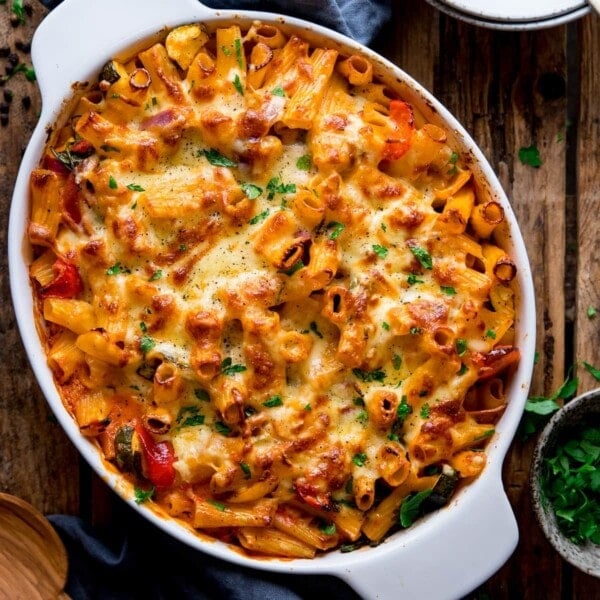
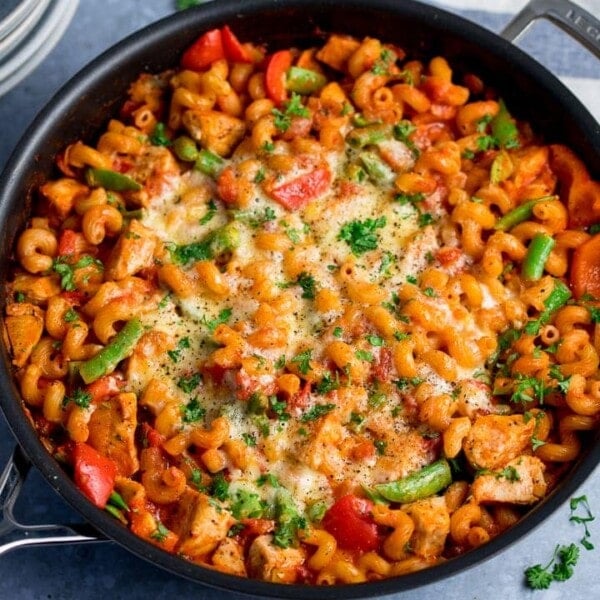
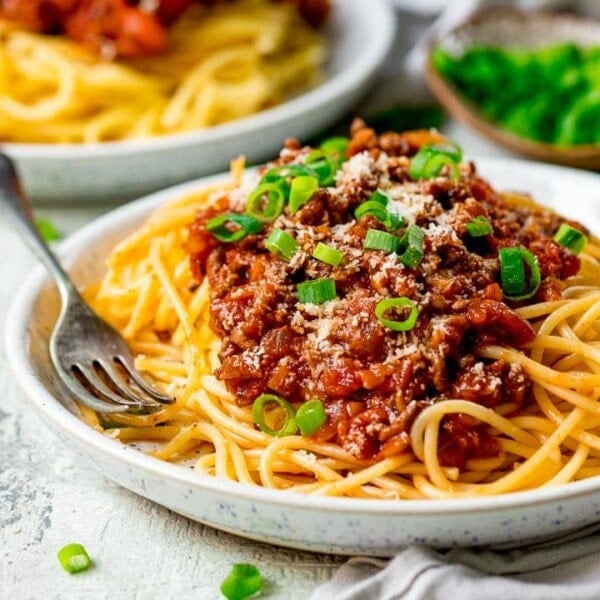
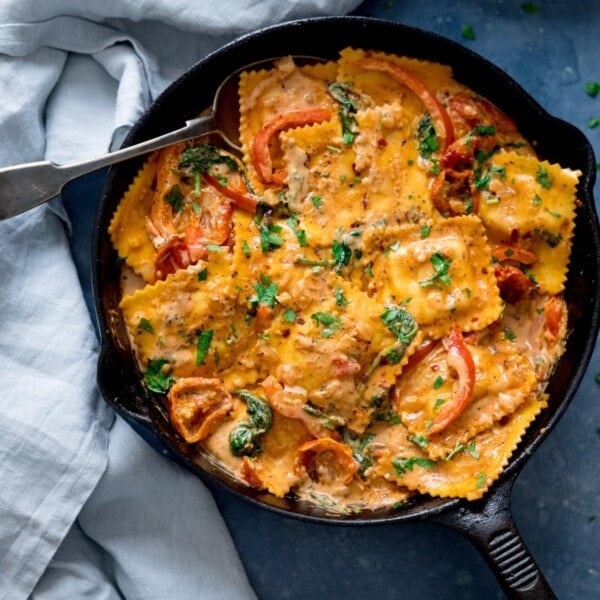







Very tasty, my husband added jalapeños to his serving, the rest of us enjoyed with some Parmesan cheese, great combination lasagne
Another winner Nicky. The flavours are beautifully balanced and move away from the cottage pie with pasta and tomatoes that is often the norm. Since there are only 3 of us here at the moment I made it in two dishes so we have to eat another one sometime. Oh dear, how sad, never mind. Someone has to do it.
Absolutely fantastic recipe. Tastes delicious and very easy to follow.
100% recommend people to try this. Great result ❤️
Seriously, the BEST lasagne recipe I’ve EVER made.
Everyone loved it, including myself and that speaks volumes!
Amount of ingredients???
Hi David,
The ingredients including amounts are all in the recipe card at the bottom of the page.
Thanks
Chris
10/q0 for this one! I really enjoyed your recipe and like you, I couldn’t wait so I just ate it. I even helped myself to another two helpings. I live in my own, it’s absolutely fine. Thank you very much for sharing. A recipe well conquered, and it was my first attempt! Winner winner Kitchen Sanctuary Receipe for dinner.
This was the first time that I’ve made a lasagne from scratch and it was lovely! Will definitely be making again!
Me too! I found it so easy to follow (and I’m not usually the best!) and it came together perfectly and looked and tasted fabulous!
Hello,
Thanks for a delightful recipe.
One thing, though: You explain how to make a Bechamel. The recipe you give is not for the Bechamel, but for the Mornay. In short, the Mornay is exactly like a Bechamel but you add cheese (Bechamel + grated cheese = Mornay)
The original Lasagna is made with Bechamel, not Mornay. The only cheese in a Lasagna is the one on the top. But since my wife loves cheese, I actually make the Lasagna with Mornay myself.
If you have fresh basil, you can add it to the chopped parsley before serving, it adds a wonderful note.
Good.
I am convinced that the meat (bolognese) sauce is even better without mushrooms but with a little finely grated celeriac and carrot fried with onions and garlic. Then I add mixed minced meat because I find beef too dry.. I also add some red wine. The rest as usual.
Concerning the béchamel I suggest adding nutmeg.
The number of layers depends on how much sauce you have. Both sauces must be distributed evenly.
I find the British rarely use celeriac or not at all, which is a pity.
Indeed we British do eat celeriac, Miroslav … but not at all regularly for most of us. I love it mashed, with butter. Not the easiest vegetable to mash, since it is a trifle fibrous. Working it through a potato ricer works, with patience! First time I tried celeriac was only a few years back, and I realised what I had been missing for so many years. It’s a lovey vegetable.
I regularly use celariac in casseroles, particularly Christmas venison as it soaks up the flavour of any spices in the dish and boosts the overall effect.
I’m all for a saucy lasagne, but I can understand that it’s not that easy to photograph (so messy to serve too).